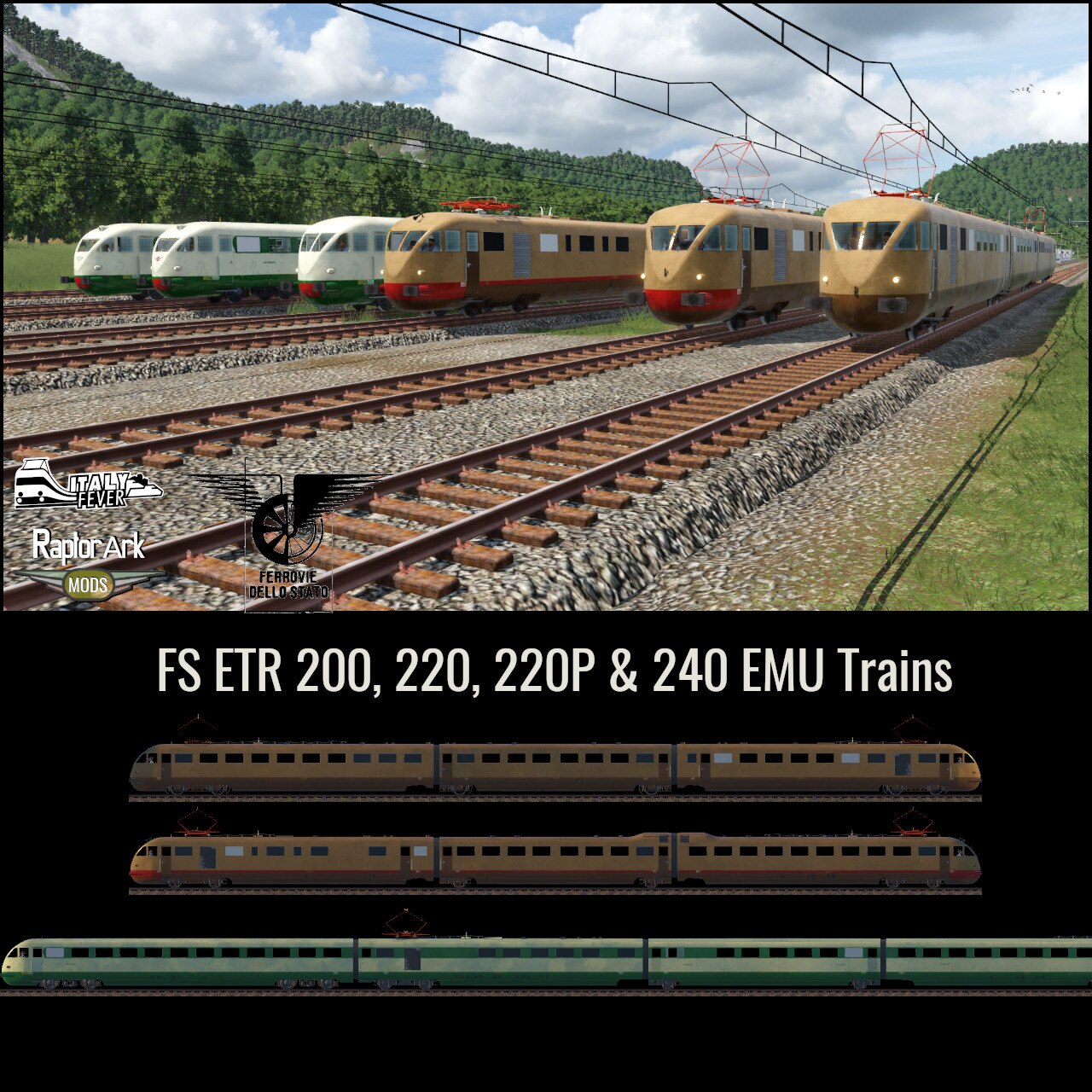FS ETR 200, 220, 220P & 240 AV trains
It is forbidden to publish my work in third part sites without my authorization.
ITALIANO
L’ETR 200 rappresenta il primo elettrotreno italiano ad essere costruito con parametri progettuali volti alla realizzazione di un rotabile ad alta velocità per servizi di prestigio.
Nell’idea iniziale, la velocità massima del convoglio era stata fissata a 140km/h. In seguito, lo sviluppo del progetto (in un periodo in cui l’esuberanza del regime portava a continui stravolgimenti tecnici) sposta tale punta massima a 160km/h.
Il treno dimostrerà comunque, nel 1939, di poter raggiungere ed oltrepassare i 200km/h di velocità massima, fissando il record mondiale (di quel periodo) a 203km/h.
L’ETR 200 si suddivide in 3 serie originali: le prime due vedono la luce tra il 1936 ed il 1938, la terza serie non vedrà mai la luce a causa dello scoppio della seconda guerra mondiale. Dal 1946 in poi, tutti i treni verranno riparati o ricostruiti, giovando di tutte le migliorie applicate nel corso del loro utilizzo.
Volendo assimilare il treno alle due prime serie, le differenze tra i treni di prima e di seconda risiedono principalmente nel tipo di carrelli e nella disposizione degli interni nella vettura di servizio (carrozza BDU per la prima serie, DU per la seconda).
A partire dal 1952, su alcuni treni venne installato il condizionatore "stone". Tale modifica richiese l’installazione di una caratteristica cupola tra le due vetture di tipo A.
Nel 1960, per mantenere il treno al passo coi tempi (visto che, nel frattempo, erano stati costruiti e sviluppati sia il settebello e sia l’arlecchino) si rese necessario effettuare un primo grande aggiornamento: vennero ordinate nuove casse alla Breda, al fine di aggiungere una ulteriore carrozza alla composizione. La trasformazione prevedeva la rimozione della testata aerodinamica dalla vettura DU, al fine di saldarla alla nuova cassa. I treni vennero riclassificati ETR 220
Nel 1965, mentre erano ancora in corso le prime trasformazioni, un ulteriore aggiornamento venne reso necessario, stavolta per il comparto tecnico: vennero installati nuovi motori tipo T165 e nuovi carrelli, praticamente gli stessi di ETR 300 ed ALe 601.
Nel 1969 le FS fissarono "l’alta velocità" a 180km/h. Per effettuare servizio stabilmente a questa velocità, alcuni ETR 220 vennero dotati di frenatura elettrica reostatica, giacchè l’impianto frenante era il punto debole di questo treno.
L’ultima modifica viene effettuata nel 1986, stavolta per ragioni puramente di risultato economico: l’allestimento interno viene completamente rivisitato per poter aumentare i posti a sedere; la vettura di servizio DU viene completamente adibita al trasporto dei viaggiatori. La capienza passa a 240 posti per i treni non AV ed a 205 per gli AV.
Il tramonto di questi treni inizia a metà degli anni 90, con gli ultimi servizi effettuati nel 2000. Attualmente, solo l’ETR 232 è inserito nell’asset dei treni storici ed è, alla data attuale di Gennaio 2022, in fase di restauro.
ENGLISH
The ETR 200 is the first Italian electric train to be built designed for high-speed and prestigious services.
In the initial idea, the maximum speed of the train was set at 140km/h. Subsequently, the development of the project (in a period in which the exuberance of the fascism led to continuous technical upheavals) moves this peak to 160km/h.
However, in 1939 the train will demonstrate that it can reach and exceed the maximum speed of 200km / h, setting the world record (of that period) at 203km/h.
The ETR 200 is divided into 3 original series: the first two were built between 1936 and 1938, the third series will never see the light due to the outbreak of the Second World War. From 1946 onwards, all trains will be repaired or rebuilt, benefiting from all the improvements applied during their use.
Talking of those early series, the differences between the first and second trains reside mainly in the type of bogies and in the arrangement of the interiors in the service car (BDU carriage for the first series, DU for the second).
Starting in 1952, the "stone" air conditioner was installed on some trains. This modification required the installation of a characteristic dome between the two type A cars.
In 1960, to keep the train in up to the times (since, in the meantime, both the settebello and the harlequin trains had been built and developed) it became necessary to carry out a first major update: new wagons were ordered at Breda, in order to to add an additional carriage to the composition. The transformation involved the removal of the aerodynamic head from the DU car in order to weld it to the new body. The trains were reclassified ETR 220
In 1965, while the first transformations were still in progress, a further update was made necessary, this time for the technical sector: new T165 type engines and new bogies were installed, practically the same as those of the ETR 300 and ALe 601.
In 1969 the FS set "high speed" commercial speed at 180km/h. To perform stable service at this speed, some ETR 220s were equipped with rheostatic electric braking, since the braking system was the weak point of this train.
The last modification was made in 1986, this time for purely economic reasons: the interior was completely revised in order to increase the number of seats; the DU service car was completely used for passenger transport. The capacity goes to 240 seats for non-high speed trains and to 205 for high speed trains.
The decline of these trains begins in the mid-1990s, with the last services performed in 2000. Currently, only the ETR 232 is included in the historical train asset and is currently undergoing restoration (January 2022).
Mod Info:
Max speed from 160 to 180km/h
Capacity from 24 to 61
Power from 1050 to 1500Kw
Year from 1939
Per contenuti addizionali:
 [www.instagram.com]
[www.instagram.com] [www.facebook.com]
[www.facebook.com]
If you like my work – se ti piace ciò che faccio:
[www.paypal.com]
Comunità Italiana Discord: https://discord.gg/dubKDaMxav



